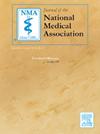Statin use and its association with all-cause mortality and incident diabetes/prediabetes in African Americans: Findings from the jackson heart study
IF 2.5
4区 医学
Q1 MEDICINE, GENERAL & INTERNAL
引用次数: 0
Abstract
Objectives
This study investigates the association between statin use and all-cause mortality, as well as the association between statin use and incident diabetes or prediabetes among African Americans.
Methods
This study is based on the Jackson Heart Study (JHS), a community-based cohort study of African Americans (AAs). The baseline period for JHS was 9/26/2000 to 3/31/2004. The first follow-up period was from 10/1/2005 to 12/21/2008, and the second follow-up period was from 2/26/2009 to 1/31/2013. All study participants who were statin users or non-users at baseline were included in this study. We applied two common propensity score adjustment techniques to analyze the data: propensity score matching (PSM) and the inverse probability of treatment weighting (IPTW) algorithms.
Results
In this cohort there were 510 deaths. The baseline prevalence of statin use was 13.95% (95% CI: 12.91% - 14.98%), while the baseline rate of all-cause mortality was 11.82% (95% CI: 10.87% - 12.82%). In crude analyses, statin users had an 80% higher risk of mortality compared to non-users, with an odds ratio (OR) of 1.80 (95% CI: 1.43 - 2.27). However, after adjusting for confounders using PSM and IPTW, the adjusted ORs for the association between statin use and mortality were 0.77 (95% CI: 0.53 - 1.12) and 0.80 (95% CI: 0.68 - 0.95), respectively. A post hoc power analysis suggested that the matched analysis was underpowered.
The incidence of diabetes/ prediabetes was 39.42% (95% CI: 37.39% - 41.45%), with 879 new cases observed. Statin users had a crude odds ratio (OR) of 2.02 (95% CI: 1.52 - 2.67) for developing diabetes/prediabetes compared to non-users. After adjusting for confounding using PSM) and IPTW, the adjusted ORs were 1.84 (95% CI: 1.21–2.81) and 1.82 (95% CI: 1.59–2.08), respectively.
Conclusion
Statin use was associated with a 20% decrease in all-cause mortality but an 80% increased risk of incident diabetes/prediabetes. Clinicians should consider the implications of these findings when prescribing statins to patients in this population.
他汀类药物的使用及其与非裔美国人的全因死亡率和糖尿病/糖尿病发病率的关系:杰克逊心脏研究的结果。
研究目的本研究调查了他汀类药物的使用与全因死亡率之间的关系,以及他汀类药物的使用与非裔美国人中糖尿病或糖尿病前期事件之间的关系:本研究基于杰克逊心脏研究(Jackson Heart Study,JHS),这是一项针对非裔美国人(AAs)的社区队列研究。JHS 的基线期为 2000 年 9 月 26 日至 2004 年 3 月 31 日。第一次随访期为 2005 年 1 月 10 日至 2008 年 12 月 21 日,第二次随访期为 2009 年 2 月 26 日至 2013 年 1 月 31 日。所有基线时使用或未使用他汀类药物的研究参与者均被纳入本研究。我们采用了两种常见的倾向得分调整技术来分析数据:倾向得分匹配(PSM)和逆治疗概率加权(IPTW)算法:该队列中共有 510 人死亡。他汀类药物的基线使用率为 13.95%(95% CI:12.91% - 14.98%),而全因死亡率的基线为 11.82%(95% CI:10.87% - 12.82%)。在粗略分析中,他汀类药物使用者的死亡风险比非使用者高出 80%,几率比 (OR) 为 1.80(95% CI:1.43 - 2.27)。然而,在使用 PSM 和 IPTW 对混杂因素进行调整后,他汀类药物使用与死亡率之间的调整 OR 分别为 0.77(95% CI:0.53 - 1.12)和 0.80(95% CI:0.68 - 0.95)。事后功率分析表明,配对分析的功率不足。糖尿病/糖尿病前期的发病率为 39.42%(95% CI:37.39% - 41.45%),观察到 879 个新病例。与未使用他汀类药物者相比,使用他汀类药物者患糖尿病/糖尿病前期的粗略几率比 (OR) 为 2.02(95% CI:1.52 - 2.67)。使用 PSM 和 IPTW 对混杂因素进行调整后,调整后的 OR 分别为 1.84(95% CI:1.21-2.81)和 1.82(95% CI:1.59-2.08):他汀类药物的使用与全因死亡率降低 20% 相关,但与糖尿病/糖尿并发症风险增加 80% 相关。临床医生在为这类人群的患者开具他汀类药物处方时,应考虑这些发现的影响。
本文章由计算机程序翻译,如有差异,请以英文原文为准。
求助全文
约1分钟内获得全文
求助全文
来源期刊
CiteScore
4.80
自引率
3.00%
发文量
139
审稿时长
98 days
期刊介绍:
Journal of the National Medical Association, the official journal of the National Medical Association, is a peer-reviewed publication whose purpose is to address medical care disparities of persons of African descent.
The Journal of the National Medical Association is focused on specialized clinical research activities related to the health problems of African Americans and other minority groups. Special emphasis is placed on the application of medical science to improve the healthcare of underserved populations both in the United States and abroad. The Journal has the following objectives: (1) to expand the base of original peer-reviewed literature and the quality of that research on the topic of minority health; (2) to provide greater dissemination of this research; (3) to offer appropriate and timely recognition of the significant contributions of physicians who serve these populations; and (4) to promote engagement by member and non-member physicians in the overall goals and objectives of the National Medical Association.

 求助内容:
求助内容: 应助结果提醒方式:
应助结果提醒方式:


